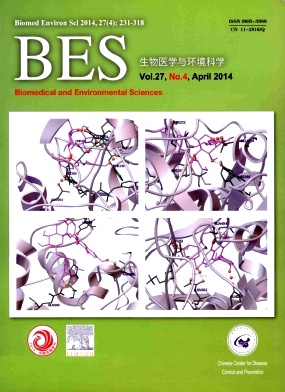Di-(n-butyl)-phthalate-induced Oxidative Stress and Depression-like Behavior in Mice with or without Ovalbumin Immunization
doi: 10.3967/bes2014.001
-
Key words:
- Di(n-butyl) phthalate /
- Atopic allergy /
- Depression /
- Mice /
- Oxidative stress /
- Behavioral tests
Abstract: Objective To investigate the relationship between atopic allergy and depression and the role of DBP in the development of depression.
Methods BALB/c mice were randomly divided into eight groups:saline;ovalbumin (OVA)-immunized;saline+DBP (0.45 mg/kg·d); saline+DBP (45 mg/kg·d); DBP (0.45 mg/kg·d) OVA-immunized; DBP (45 mg/kg·d) OVA-immunized; saline+hydrocortisone (30 mg/kg·d); and hydrocortisone (30 mg/kg·d)-exposed OVA-immunized. Behavior (e.g. open-field, tail suspension, and forced swimming tests), viscera coefficients (brain and spleen), oxidative damage [e.g. reactive oxygen species (ROS), malondialdehyde (MDA), and glutathione (GSH)], as well as levels of IgE and IL-4, were then analyzed.
Results In the saline and OVA groups, the degree of depression symptoms in mice increased with increasing DBP concentration. Additionally, the OVA-immunity groups were associated with more serious depressive behavior compared with the same exposure concentration in the saline group. Oxidative damage was associated with a dose-dependent increase in DBP in the different groups. IL-4 and IgE levels were associated with low-dose DBP stimulation, which changed to high-dose inhibition with increasing DBP exposure, possibly due to spleen injury seen at high DBP concentrations.
Conclusion Development of an atopic allergy has the potential to increase the risk of depression in mice, and it seems that DBP helps OVA to exert its effect in our present model. Moreover, the results of our study implicate a certain connection between brain oxidative stress and depression, which deserves a further exploration.
| Citation: | ZUO Hao Xiao, LI Jin Quan, HAN Bing, KE Chen Juan, LIU Xu Dong, ZHANG Yu Chao, LI Li, YANG Xu. Di-(n-butyl)-phthalate-induced Oxidative Stress and Depression-like Behavior in Mice with or without Ovalbumin Immunization[J]. Biomedical and Environmental Sciences, 2014, 27(4): 268-280. doi: 10.3967/bes2014.001 |







 Quick Links
Quick Links
 DownLoad:
DownLoad: